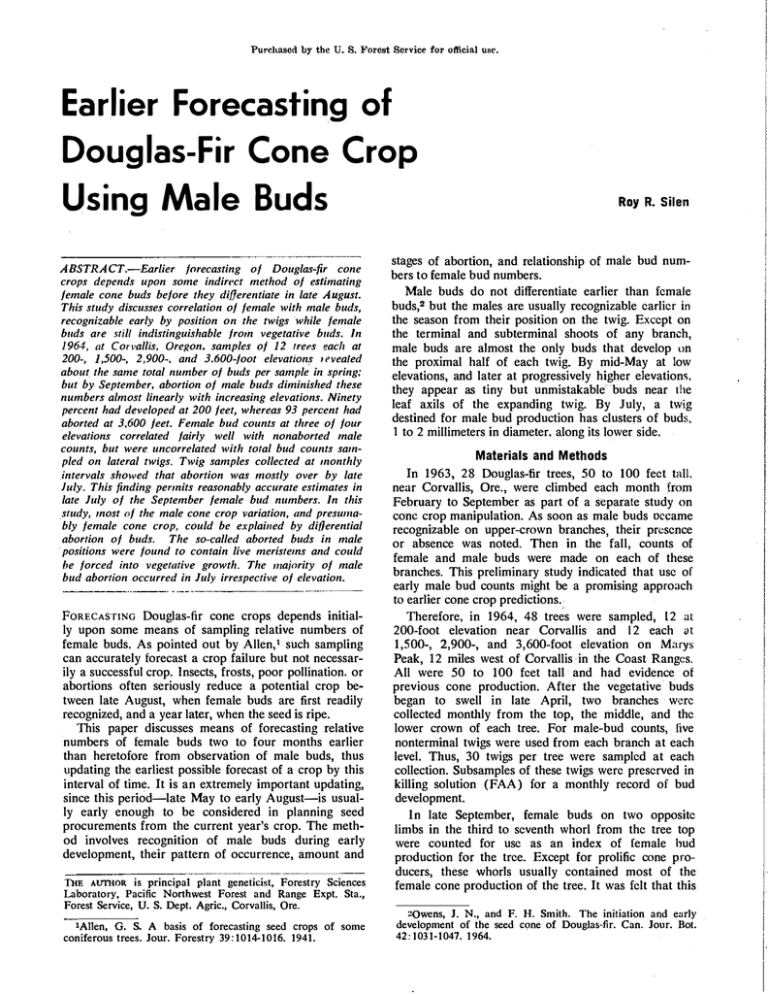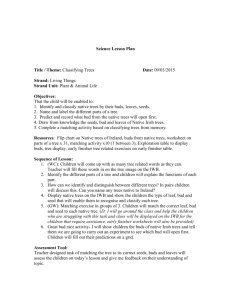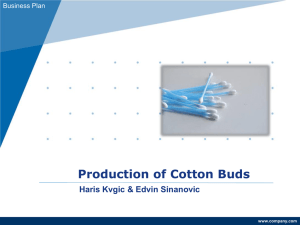Earlier Forecasting of Douglas-Fir Cone Crop
advertisement

Purchased by the U.S. Ji'orest Service for official use. Earlier Forecasting of Douglas-Fir Cone Crop Using Male Buds ABSTRACT.-Ear/ier forecasting of Douglas-fir cone crops depends upon some indirl'Ct method of estimating female cone buds before they differentiate in late August. This study discusses correlation of female with male buds, recognizable early by position on the twigs while female buds are still indistinguishable fro1n vegetative buds. In 1964, at Corvallis, Ore[Jon, samples of 12 trees each at 200-, 1,500-, 2,900-, and 3,600-foot elevations ievea/ed about_ the san1e total number of buds per sample in spring; but by September, abortion of male buds diminished these numbers almost linearly with increasing elevations. Ninety percent had developed at 200 feet, whereas 93 percent had aborted at 3,600 feet. Female bud counts at three of four elevations correlated fairly well with nonaborted rnale counts, but were uncorrelated with total bud counts sa1n­ pled on lateral twigs. Twig samples collected at 1nonthly intervals sho}ved that abortion was mostly over by late July. This finding pennits reasonably accurate estimates in late July of the September female bud numbers. In this study, rnost of the male cone crop variation, and presu111a­ bly female cone crop, could be explained by differential abortion of buds. The so-called aborted buds in male positions were found to contain live meriste1ns and could he forced into vegetative growth. The 111ajority of male bud abortion occurred in July irrespective of elevation. ---- ----- -·------ FORECASTING Douglas-fir cone crops depends initial­ ly upon some means of sampling relative numbers of female buds. As pointed out by Allen, 1 such sampling can accurately forecast a crop failure but not necessar­ ily a successful crop. Insects, frosts, poor pollination. or abortions often seriously reduce a potential crop be­ tween late August, when female buds are first readily recognized, and a year later, when the seed is ripe. This paper discusses means of forecasting relative numbers of female buds two to four months earlier than heretofore from observation of male buds, thus updating the earliest possible forecast of a crop by this interval of time. It is an extremely important updating, since this period-late May to early August-is usual­ ly early enough to be considered in planning seed procurements from the current year's crop. The meth­ od involves recognition of male buds during early development, their pattern of occurrence, amount and THE AUTIIOR is principal plant geneticist, Forestry Sciences Laboratory, Pacific Northwest Forest and Range Expt. Sta., Forest Service, U. S. Dept. Agric., Corvallis, Ore. 1A1Jen, G. S. A basis of forecasting seed crops of some coniferous trees. Jour. Forestry 39:1014-1016. 1941. Roy R. Silen stages of abortion, and relationship of male bud num­ bers to female bud numbers. Male buds do not differentiate earlier than female buds,• but the males are usually recognizable earlier in the season from their position on the twig. Except on the terminal and subterminal shoots of any branch, male buds are almost the only buds that develop on the proximal half of each twig. By mid-May at low elevations, and later at progressively higher elevations, they appear as tiny but unmistakable buds near 1he leaf axils of the expanding twig. By July, a twig destined for male bud production has clusters of buds, I to 2 millimeters in diameter, along its lower side. Materials and Methods In 1963, 28 Douglas-fir trees, 50 to 100 feet tall, near Corvallis, Ore., were climbed each month from February to September as part of a separate study on cone crop manipulation. As soon as male buds occame recognizable on upper-crown branches, their presence or absence was noted. Then in the fall, counts of female and male buds were made on each of these branches. This preliminary study indicated that use of early male bud counts might be a promising approach to earlier cone crop predictions. Therefore, in 1964, 48 trees were sampled, 12 at 200-foot elevation near Corvallis and 12 each at 1,500-, 2,900-, and 3,600-foot elevation on Marys Peak, 12 miles west of Corvallis in the Coast Ranges. All were 50 to I 00 feet tall and had evidence of previous cone production. After the vegetative buds began to swell in late April, two branches were collected monthly from the top, the middle, and the lower crown of each tree. For male-bud counts, five nonterminal twigs were used from each branch at each level. Thus, 30 twigs per tree were sampled at each collection. Subsamples of these twigs were preserved in killing solution (FAA) for a monthly record of bud development. In late September, female buds on two opposite limbs in the third to seventh whorl from the tree top were counted for use as an index of female bud production for the tree. Except for prolific cone pro­ ducers, these whorls usually contained most of the female cone production of the tree. It was felt that this 2Qwens, J. N., and F. H. Smith. The initiation and ear]y development of the seed c9ne of Douglas-fir. Can. Jour. Bot. 42: 1031-1047. 1964. · third-to-seventh-whorl stratification would give a less variable estimate of the tree's relative female bud product!uu than total count. Counts of male buds on sample twigs were made under a binocular microscope if they were not plainly visible to the naked eye. Bud data for 1964 were analyzed by simple correlation methods. The preserved twig samples from each monthly collection provided and subsequently a good female cone crop in 1964, had few or no abortions of the developing male buds between May and August 1963. But abortion of part material for estimating when bud abortions occurred. Final counts of aborted and nonaborted male buds were 1t1ade on fall-collected twigs. male bud abortion. The 1964 cone crop was poor at 1,500, 2,900, and 3,600 feet, corresponding to the heavy abortion of male buds at higher elevations. The crop was medium to good at low elevation, where the sampled trees also showed least abortion of male buds. Results 1963 observations.-At first glance, results of the or all the potential male buds was commonly observed on the trees producing medium, poor, or no crops. This proved to be the key to the problem. In retrospect, the prediction would have been quite useful had we considered the elevational differences in 1963 exploratory study, presented in Table 1, would seem entirely negative. Of 24 trees displaying signs of 1964 study.-Following the major lead from the 1963 study, attention in the 1964 study was concen­ male buds in spring, 12 produced cone buds in that fall and 12 did not. Two further observations, howev­ trated on ( 1) ascertaining if counts of nonaborted er, were more encouraging. First, the four trees that showed no buds in male position in the spring were male buds were closely related to female bud counts and ( 2) learning the developmental pattern of normal and aborted buds by observing time that buds are first without cone buds that fall. Secondly, it was noted that the trees having a good male bud potential in 1963, visible, when abortions occur, and fate of aborted buds. Fig. 4.-Male, female, and total bud numbers related to elevation. Total buds refer to all lateral buds seen on the twig. By adjusting female bud count scale to same length as male count scale, all four relationships of the paper are illus­ trated: (1) the strong reationship be­ tween female bud counts and counts. of nonaborted male buds, (2) lack of rela­ tionship between female and total bud counts, (3) similarity of total-bud counts at all elevations, and (4) almost linear decrease in cone buds with increasing elevation. Each point is the composite count of the sample from 12 trees. TOTAL ANO MALE bud count 1.600 FEMALE bud count 1.000 900 1.400 BOO 1.200 1.000 'l '\\ Nonaborted llALE \ BOO "' 600 \ 500 Fig. 1. Fig. 2. Fig. 3. 600 400 Fig. 1.-Buds within a bud. Douglas-fir buds1 presumably male1 were seen on the tiny shoot still inside the bud scales in April. Bud scales and needles are removed. (9XJ 400 Fig. 2.-Budsi presumably male, on a partially elongated Douglas-fir shoot in late May. Needles have been removed. (2XJ 200 Fig. 3.-Dougas-fir twig in September showing male buds. Large buds in clusters are normally developing buds. Others have aborted at earlier stages, the maiority by mid­ July, 12Xl Dl!CEMBER, 1967 300 200 ',L--.,-",i,",..--.,,,.,ioo"'o--,•"o'=ooc- """,:-!.o·oo ELEVATION I-) 889 Table 1.-Results of 1963 Male Bud and 1964 Cone-Crop Sampling on Marys Peak and Near Corvallis, Ore. (Basis is seven trees at four elevations} Spring 1963 1nale bud indication Elevation (feet) Tree s with 200 1,500 6 7 3,600 5 2.900 1 AU four cone crop. trees whereas predictions depending on numbers of nona­ borted male buds could not be made before late July. An observation u( possible significance w_.. s that much of the halting of bud development of the 1964 season occurred sometime between the July I and August I collection at all elevations. Buds were fairly well developed at the 20Moot elevation but hardly pinhead size at 3,600 feet when bu<!s aborted. Dissection of many aborted 1>uds in the fall of 1964 revealed that each had a living meristem. To deter­ mine if these could be forced into growth, all twigs on three branches of three trees were pruned at about half length and all developing male or vegetative buds on the basal portion of the branch were removed, leaving only "aborted" buds. On all treated branches. these aborted buds began to grow, some breaking in the spring of 1965 as vegetative buds. Most had developed or burst by fall of 1965, and all were vegetative. (Although the so-called aborted buds were found to be simply latent, the terms "aborted" and "nonaborted" will still be used for consistency.) 1964 number of trees with- Trees1 without Over 500 cones 100Less 500 than 100 No cones cones cones 1 0 1 2 3 1 5 5 5 2 1 I I I 1 with no early male crop indication had no 1964 Bud de ve/opment.-Observations made in 1964 from twigs fixed in FAA at times of collection showed that the whole complement of 1965 buds was visible on the slightly elongated shoot still inside the unburst bud in the spring of 1964 (Fig. 1). This observation can be made as early as April at low elevations. Bud counts on these tiny shoots were made by stripping away the small needles. Total bud counts per shoot in this stage (mean 10, range 4-19, based on 36 observa­ tions) correspond closely to total bnd counts made on shoots of similar origin at season's end. Relationship between male and female bud num­ bers.-Luckily, the developmental history of each bud is clearly visible on the fall-collected twigs. Hence, these can be used to compare directly the total number of buds that started with the number that were still developing in the fall (i.e., the nonaborted buds), thus avoiding the problem of sampling error between sepa­ rate spring and fall collections. Table 2 and Figure 4 summarize numbers of fe­ male, nonaborted male, and total (lateral buds of all types) buds observed in the fall twig collection from the 48 trees. Female bud numbers on the four plots decreased with increased elevation in almost a linear manner, especially when fall totals for each sampled elevation were compared. So did fall numbers of nonaborted male buds. The relationship of total female and total nonaborted male bud numbers, pooled for 12 trees at each of the four elevations, is strikingly straight­ forward (r = 0.99, 2 d.f.). Thus, to the extent that abortion is complete at time of sampling, an adequate Records were made of the stages when bud abortion occurred. Some buds developed no further following bud burst but were still visible under a binocular microscope in the fall, appearing as tiny mounds near the axils of the leaves. Others developed for a few weeks to the stage shown in Figure 2, then stopped growing. Still others continued to develop only to abort after considerable increase in size-some were nearly full size before aborting. An example of a twig having all stages of aborted buds is seen in Figure 3. Twig samples collected at monthly intervals indicated that most abortions had occurred by mid-July. Hence, useful predictions of failures could be made very early Table 2.-Female,1 Nonaborted Male, and Total Lateral Bud2 Numbers in the Upper Crowns of 12 Trees at Each of 4 Elevations near Corvallis, Ore., Fall 1964 Sampled tree number I 2 3 4 5 6 7 8 9 200 feet 183 27 21 5 5 29 12 18 6 76 167 159 202 Total 898 IO II 1,500 feet 130 1 00 4 0 0 51 2,900 feet 55 0 0 0 103 62 36 42 17 8 15 134 0 48 13 0 0 581 333 0 Percent male buds nonaborted 200 1,500 feet 2,900 feet 0 214 168 172 113 112 27 0 131 114 84 94 133 205 162 96 0 0 87 0 92 97 76 90 3 24 113 0 13 0 29 38 0 18 18 0 0 125 1,362 908 253 90 62 20 3,600 feet 0 0 25 42 5 0 33 7 0 3 IO Total lateral bud sample (aborted, nonaborted, and vegetative) at elevations of-· Nonaborted male buds at elevations of- Female buds at . levations offeet 3,600 foet 200 1 , 5 00 feet 2,900 feet 3,600 feet 0 216 169 178 118 126 205 115 127 145 93 0 0 0 0 0 0 43 143 130 84 99 147 90 138 112 83 104 93 120 134 58 86 64 134 90 129 127 137 81 95 117 111 116 187 180 123 133 90 115 138 116 108 II 1,519 1,476 1,255 1,534 0 0 I IO 0 feet 66 Ill 1 Female bud sample is total number of female buds from two opposite limbs in whorls 3 to 7 from the top of the tree. s Male and total bud sample is from five twigs each from two main branches in the upper crown. Total bud number includes all lateral buds in this sample. 890 JOURNAL OF FORESTRY Table 3.-Correlation Coefficients of Bud-Number Comparisons Elevation (feet) 200 1,500 2,900 3,600 Pooled Female vs. nonaborted male buds Female vs. total buds Number of comparisons 77' 81' 18 71' 58' 19 66' 17 49 30' 12 12 12 12 48 t Significant at I percent level. 2 Significant at 5 pcrct'nt level. development. A crop failure apparently can be reliably forecast if few buds are found in the male position or alternatively as soon as bud abortion is evident. This could be as early as June. Apparently, male catkins never develop from buds that halt development for an appreciable part of the growing season. On the other hand, the risks associated with forecast­ ing a cone crop from early male bud development are, of Course, even higher than from sampling femalt! buds in September. However, if the only information desired in July and August is whether there is a potential for a crop next year, then this information sample of nonaborted male buds pooled for at least 12 trees in a stand is useful in predicting nnmber of female buds in a similarly pooled sample. No relationship was found between total buds and female buds. Both male and total bud numbers are from the male-bud sample made in the fall. At every elevation, total bud numbers were surprisingly similar, whereas female bud numbers differed almost 7: 1 between high and low elevation. Jn a year when there is little abortion, total bud count might correlate better with female bud numbers. These results, like those in 1963, indicate that the aborted buds arc the key to the problem. Despite the clear pattern (Fig. 4) that emerged from a pooled sample of trees, comparisons of 1nale and female bud numbers on individual trees revealed surprising variation. Some trees produced female buds but few or no nonaborted male buds, and vice versa. The 2,900-foot plot had several such trees that over­ rode the general trend. However, at three elevations the relationship of nonaborted male to female buds is highly significant, and the pooled correlation coeffi­ cient is 0.58 which is highly significant (Table 3). Part of the aberrant relationship between nonaborted male and female bud numbers on some trees arises from characterizing a whole tree from a sample of two upper-crown branches. Most of the trees that produced over I 00 female buds in the sample showed little abortion of male buds, and most of the trees where male abortion was complete produced few or no female buds. The best sampling of male buds was from the upper crown. This might be expected since most female buds are produced in the upper crown. Increasing variation was found in samples from middle and lower crown. Part of the variation in lower-crown samples was be­ cause many of the trees were in stands with shaded lower crowns. Discussion Both the 1963 and 1964 studies suggest .that, with seems clearly obtainable. These results suggest a first prediction of the coming crop can be made as soon as shoots begin elongation, or 16 months prior to seedfall. Failure to find general clustering of buds on nonterminal twigs in upper-crown branches would be a first indication of crop failure. After mid-July, male buds that continue developing have reasonably good predictive value for female bud production. By this time, developing and aborted buds are easily distinguished by size. A more accurate prediction is possible if male bud counts are made in August. For any one location, a composite sample from trees of potential cone-bearing size is necessary, since prediction for a single or sn1all number of trees is risky due to natural variation. For instance, a 12-tree sample was adequate at three of four locations, but a single aberrant value in the 2,900-foot sample caused the relationship there to be nonsignificant. Sampling is most accurate on branches of the upper crown. The climbing necessary for obtaining such samples poses a question of a practical sampling method for commer­ cial seed collectors. A promising area for further study would be to sample the lower crown of open-grown trees in comparing areas, since such trees are capable of setting good female crops on lower limbs. The study raised several interesting questions. One was the finding that the majority of buds that halted development did so between the July I and August I collections, irrespective of elevation. In 1964, we also collected samples of twigs at the Dennie A hi Seed Orchard near Shelton, Wash., and our best estimates were that the majority of abortions occurred at stages corresponding to the July period. Does hailing of bud development occur at the same time over much of the region? No speculations are presently appropriate as to whether these observations were mere coincidences or what factors may be involved. Another observation that aborted buds have living. though dormant, meristems raises more questions. Are these clusters of dormant buds the source of epicormic­ like shoots on limbs and branches? Apparently so. Even without forcing treatments, 1nany break dorman­ cy several years later and finally appear as clusters of short shoots on branch or stem. The finding that these skillful interpretation, numbers of normally developing buds in the male position are useful in forecasting the relative numbers of female buds in the fall. By time of differentiation, numbers of nonaborted males are fairly well correlated with female bud numbers on a stand basis and ronghly correlated on a tree-by-tree basis. The stand basis is of far more importance commer­ cially. buds, when forced, become vegetative and not male raises the question of whether they were ever male. The most compelling evidence that there was a floral potential in these buds sometime before development halted is that on 12 trees at each elevation about the same number of buds started development, but, after Reliability of any prediction using male buds varies with type of information desired and course of bud varying degrees of bud abortion, each elevation ended up with greatly differing male and female bud nmn- DECEMBER, 1967 891 bers. Apparently all the buds, latent or active, were conserved. Does each tree have the capacity to cause floral buds to become dormant and vegetative at any time in the growing season? Perhaps the most basic question raised by the study is seen in Figure 4. Differences in the cone crop at four elevations seem based on the differing amounts of abortion rather than on failure of floral bud initiation. Is there a switching from potentially floral to potential­ ly vegetative stage Jong before the buds differentiate? This question has led us to a number of studies to be subsequently reported, aimed at learning if floral initi­ ation could have taken place before bud bursting-five months before cone buds have differentiated and 17 months ahead of seedfall-and if change from floral to vegetative stage is a major process in control of cone crops. If so, techniques that might prevent bud abor­ tions would be of more immediate use in enhancing cone production than those aimed at floral initiation. Our observations of two seasons, plus bud counts on twigs of earlier years, indicate buds will usnally be found in adeqnate numbers on enough trees in most stands to produce cone crops almost every year if al l the buds continue normal development.





